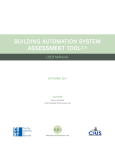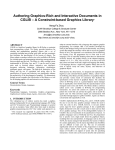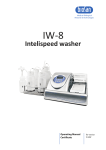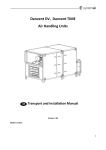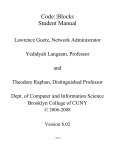Download BASAT 2.7 User Manual - CUNY Building Performance Lab
Transcript
BUILDING AUTOMATION SYSTEM ASSESSMENT TOOL 2.7 USER MANUAL SEPTEMBER 2015 AUTHOR Marco Ascazubi CUNY Building Performance Lab CONTENTS 1. OVERVIEW ................................................................................................................................................3 2. GETTING STARTED....................................................................................................................................3 NAVIGATION........................................................................................................................................3 BASAT STRUCTURE ..............................................................................................................................4 Inputs – Survey Forms ..................................................................................................................4 Outputs – Structured Spreadsheets..............................................................................................7 3. PERFORMING AN ASSESSMENT ...............................................................................................................8 EQUIPMENT/SYSTEM SPECIFIC SECTIONS ...........................................................................................8 PROTOCOL SPECIFIC SECTIONS ...........................................................................................................8 CAVEATS AND EXCEPTIONS .................................................................................................................9 PAGE 2 | BUILDING AUTOMATION SYSTEM ASSESSMENT TOOL | USER MANUAL 1. OVERVIEW The Building Automation System Assessment Tool (BASAT) was created to evaluate existing commercial building infrastructure by assessing the capabilities of Building Automation Systems (BAS). BASAT accomplishes this by using its embedded logic to classify the availability of these capabilities based on specific combinations of sensors, actuators and points found during a survey of the BAS interface. The goal of the tool is to enable widespread adoption by commercial building operators of “advanced functionalities” that are available from the controls industry but are dramatically underutilized. In some cases, functions can be implemented with just programming and operator instruction (controls retrocommissioning); while in other cases hardware additions or substantial system replacement may be necessary (BAS upgrades, sensors, actuators). 2. GETTING STARTED BASAT is a structured spreadsheet tool that can be used to assess Building Automation Systems and provide insight into any specific controls optimizations of, or measures that can be realized with, the current BAS configuration; as well as an indication of the possible measures given additions of specific sensors, actuators and points to the BAS. The tool consists of the following: Input sections in the form of survey lists, in which the user selects the availability of sensors based upon examination of the BAS front-end and operator knowledge of the system. System-, equipment- and protocol-specific results sections in which the results of the survey are computed based on a decision matrix that determines the availability of measures, control strategies and controls optimizations. NAVIGATION Much like any other workbook, the various sections of BASAT, represented by individual spreadsheets, can be accessed by clicking on the spreadsheet label tab located at the bottom of the Excel window. In addition, a menu sheet that contain links to all other sheets in BASAT is also available and accessible from any other sheet. As an alternative way to move between sheets, each sheet has a left and right button on each side which moves to the next or previous sheet as shown below: Figure 1. Menu Sheet PAGE 3 | BUILDING AUTOMATION SYSTEM ASSESSMENT TOOL | USER MANUAL BASAT STRUCTURE BASAT can be used to evaluate the capabilities of a BAS in two ways: 1) to look at the specific capabilities or measures available to the BAS for a certain building system (e.g., Cooling Plant, Heating Plant, etc.); and 2) to determine the level of compliance with a specific protocol (e.g., Building Re-tuning, NYC Local Law 87, etc.). In its current iteration (2.7.5), the systems and equipment that can be evaluated with BASAT are: Cooling Plant Heating Plant Air Handler Unit (CHW) Zone Ambient The protocols through which BASAT can present the results of an assessment include: Building Re-tuning (BRT) Fault Detection Diagnostics (FDD) Lean Energy Analysis (LEAN) Demand Response (DR) New York City Local Law 87 (LL87) In addition, this version of BASAT includes a section called “Point Stats” which provides a summary of the number of measures in each protocol that requires each specific point (sensors and actuators). This section informs the user about the most essential points for potential upgrades to BAS infrastructure in order to comply or fulfill the highest amount of measures assessed in BASAT. PAGE 4 | BUILDING AUTOMATION SYSTEM ASSESSMENT TOOL | USER MANUAL Inputs – Survey Forms There are two types of input sections in BASAT. The first is the General Building Details, which includes the following (refer to Figure 2): ❶ Building Information (building name, address, description) ❷ Surveyor Information (name, company, contact info and visit date) ❸ Control System Information (manufacturer, software version, year installed and system installer) ❹ A Next Section button that brings up the next spreadsheet. ❺ A Clear Information button that once clicked clears data entered in the three fields above ❻ A Clear All button that resets all sections and returns all inputs their default of “No”. ❼ An indicator of the current BASAT version and date of last update. GENERAL BUILDING DETAILS 4 5 6 1 2 3 7 Figure 2. BASAT “General Building Details” section layout PAGE 5 | BUILDING AUTOMATION SYSTEM ASSESSMENT TOOL | USER MANUAL The second type of input section is system-specific and consists of the survey/checklist style spreadsheets for each system that contain the following (refer to Figure 3): ❶ Lists of sensors, actuators and points (data points) needed for all the BAS capabilities assessed. Each of these lists represents a group of points of similar type within the system in question (e.g., Temperatures, Dampers, Coils/Valves, Fans and Filters in the AHU section). ❷ “Yes” or “No” radio buttons for each of the data points in the lists which can be filled in by the user to indicate the availability of each data point in the BAS interface. ❸ A Generate Results button that activates BASAT’s logic and brings up the Results Section for that particular system. ❹ A Reset Results button that resets all point selections to their default of “No”. ❺ A “Notes” section in which the user can record any additional or important information about the system. 3 SYSTEM / PROTOCOL INPUTS 1 1 2 4 1 2 1 2 2 5 Figure 3. BASAT input section layout PAGE 6 | BUILDING AUTOMATION SYSTEM ASSESSMENT TOOL | USER MANUAL Outputs – Structured Spreadsheets BASAT presents outputs in a structured spreadsheet form for each system and protocol. The spreadsheet contains the following (refer to Figure 4): ❶ Building Details (Name, Address and Description) and Control System Information (BAS Manufacturer, Version, Year Installed and Installer). ❷ A list of data points available (user selected “Yes” on input sheets). ❸ A list of data points to add or unavailable (user selected “No” on input sheets). ❹ A list of the capabilities assessed. ❺ The availability of each specific capability or measure – Possible values in this section are “Yes”, “No” and “Yes*” (“Yes*” indicates capability is available but with an exception or important note). ❻ A list of additional data need for each specific capability where a “No” resulted for its availability. ❼ A notes section in which any additional information about each capability is displayed, if any. ❽ An Update Selection button that takes the user back to the input section so that any changes needed to the survey can be applied. ❾ A Reset Selection button that clears the output and input sheets for the system in question. 8 SYSTEM / PROTOCOL OUTPUTS 9 1 2 4 5 6 7 3 Figure 4. BASAT output section layout PAGE 7 | BUILDING AUTOMATION SYSTEM ASSESSMENT TOOL | USER MANUAL 3. PERFORMING AN ASSESSMENT A typical BASAT assessment begins by accessing the BAS front-end and proceeding to complete the BASAT input sections based on a visual inspection of the BAS graphical user interface (GUI) screens. EQUIPMENT/SYSTEM SPECIFIC SECTIONS 1) Fill out the General Building Details spreadsheet at the start of the assessment; once completed, click the Next Section button located at the top right of the spreadsheet. 2) Complete the Ambient section by bringing up the BAS screens that contain the sensors listed and verify if these are available. Click on the “Yes” radio button if the sensor exists or leave the default “No” radio button selection if the sensor is not tied in to the BAS. Make any notes in the “Notes” area at the bottom of the sheet, if necessary. Tip: The “Notes” area is a merged range of cells; a new line can be created by pressing the ALT+ENTER keys. 3) Once the Ambient section is completed, click on the Next Section button to bring up the Zone section. Follow the same procedure as before, making sure to bring up the appropriate BAS screen, and click on the Next Section button once the Zone section is completed. 4) With the Zone section completed, the system of choice can be selected via the spreadsheet tabs located at the bottom of the Excel window. For instance, if you are interested determining the capabilities of the BAS in relation to the Air Side and Handler Units, then you can proceed to click the corresponding AHU spreadsheet and perform the survey, just as with the previous sections. 5) Once the survey for the desired system is completed, click on the Generate Results button. This will bring up the corresponding Results spreadsheet, in which the results of the survey are displayed. 6) The previous steps can be repeated for assessment of the remaining systems. PROTOCOL-SPECIFIC SECTIONS The sections that present results through the lens of a specific protocol do not have an input section, with the exception of the Demand Response section. To generate results in the LEAN and LL87 sections of BASAT, perform the following steps: 1) Complete all other input sections (those that are applicable for the particular facility being analyzed), as these are used by the logic embedded in the protocol-specific sections, including Demand Response. 2) Navigate to the desired protocol section and click on the Generate Results button located at the top right of the spreadsheet. This will populate the results in a similar fashion as the system-specific sections. PAGE 8 | BUILDING AUTOMATION SYSTEM ASSESSMENT TOOL | USER MANUAL CAVEATS AND EXCEPTIONS The Demand Response section requires the completion of other system-specific input sections, as well as its own input section, which lists data points that are specific to demand response strategies. Sections dedicated to specific equipment (AHU, Cooling Plant and Heating Plant) have an ID field at the top of the spreadsheet. This field can be used to differentiate multiple pieces of equipment when carrying out an assessment for multiple pieces of equipment with varying point configurations. Each results section/spreadsheet has a counter, at the top right of the sheet, that indicates how many capabilities are available out of the total number of capabilities assessed by BASAT for that specific system/protocol. PAGE 9 | BUILDING AUTOMATION SYSTEM ASSESSMENT TOOL | USER MANUAL









